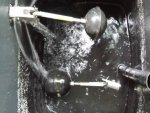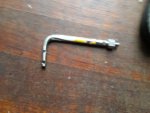Some years ago, I built a DIY chlorinator that uses the principle of the 'Liquidator'
I have always had problems with the float valves, because the original Liquidator is not available in Australia, & until now, I have ot found reasonably priced Float valves.
The valves have jammed (over a season) with scale, & the chlorine gradually eats the HDPE valves.
I have now found proper stainless 316 float valves available here:
<http://www.ebay.com.au/itm/3-4-Valve-Body-Cocky-Valve-/331895750990?hash=item4d4687414e:g:ylAAAOSwhOVXdH-u>
The arms are available separately, & also a 10mm to 5/16 UNC adaptor for other floats (use HDPE or PVC) You need 150mm arms. Also replace the rubber seals with Viton. (they are a rubber disc)
In my installation, I use Silicon rubber lined hose, & have a simple clamp to regulate the flow (DIY from stainless).
I have never found a one-way valve that lasts for the feed line, so my system drains down when the pump stops. (Not an issue as lng as the suction side valve seals).
btw, the way I adjust the flow is by gradually adjusting the regulator clamp over some days, while watching the chlorine level. Once set, it never seems to need adjusting.
My tank is a (new) HDPE waste bin (as in a wheelie bin for rubbish). 120Litre capacity, with the top float valve near the top, & the suction float valve about 300mm (a foot!) down, so the tank easily holds about 40L (9 US Gals?) of chlorine, which lasts about a month. I have a 25mm plastic pipe running to the bottom of the tank to fill the chlorine, which I safely transfer by siphoning (1/2" hose, fill with water, block one end & put the other end in the elevated chlorine container. The blocked end is then uncapped as it is put into the loading pipe that goes to the bottom of the tank. )
I also use a Copper/Silver Ioniser, & keep the Chlorine level at about 1>2 ppm.
This system really works well! Due to equipment failure at the end of last season, my pool went green. Over the next 3 months, it went to black: ie really putrid! At the beginning of this season, after repairing the failure, I checked the water, balanced it up a bit, then ran the pump on recirculate for 2 days after recharging the chlorinator with 15L of chlorine. I used the pole skimmer sock & removed as much muck as I could, & gradually the pool cleared without any more chemicals! I find the sock removes the dead algae quite effectively. Once reasonably clear, I vacuumed, & backwashed the filter, then finished commissioning the pool. (My pool is covered with Shadecloth, so I do not use stabiliser, but suffer chlorine loss during the day. The pool is never in direct sun.) It is always on the cold side though!
When everything is working, my pool never goes green. The only chemicals I use is Liquid chlorine, acid, Calcium salt & buffer. The Ioniser keeps the algae at bay, & everyone comments how soft the water is in my pool. WE use extreme water conservation, because we live on rain water, so must conserve water. I pump excess water to a 1000Gal holding tank when rain overfills the pool, then use it for topping up. Even backwash water is settled, then re-used.
I will put up more info when the new valves arrive & are installed (inc photos).
regards, Doug.
I have always had problems with the float valves, because the original Liquidator is not available in Australia, & until now, I have ot found reasonably priced Float valves.
The valves have jammed (over a season) with scale, & the chlorine gradually eats the HDPE valves.
I have now found proper stainless 316 float valves available here:
<http://www.ebay.com.au/itm/3-4-Valve-Body-Cocky-Valve-/331895750990?hash=item4d4687414e:g:ylAAAOSwhOVXdH-u>
The arms are available separately, & also a 10mm to 5/16 UNC adaptor for other floats (use HDPE or PVC) You need 150mm arms. Also replace the rubber seals with Viton. (they are a rubber disc)
In my installation, I use Silicon rubber lined hose, & have a simple clamp to regulate the flow (DIY from stainless).
I have never found a one-way valve that lasts for the feed line, so my system drains down when the pump stops. (Not an issue as lng as the suction side valve seals).
btw, the way I adjust the flow is by gradually adjusting the regulator clamp over some days, while watching the chlorine level. Once set, it never seems to need adjusting.
My tank is a (new) HDPE waste bin (as in a wheelie bin for rubbish). 120Litre capacity, with the top float valve near the top, & the suction float valve about 300mm (a foot!) down, so the tank easily holds about 40L (9 US Gals?) of chlorine, which lasts about a month. I have a 25mm plastic pipe running to the bottom of the tank to fill the chlorine, which I safely transfer by siphoning (1/2" hose, fill with water, block one end & put the other end in the elevated chlorine container. The blocked end is then uncapped as it is put into the loading pipe that goes to the bottom of the tank. )
I also use a Copper/Silver Ioniser, & keep the Chlorine level at about 1>2 ppm.
This system really works well! Due to equipment failure at the end of last season, my pool went green. Over the next 3 months, it went to black: ie really putrid! At the beginning of this season, after repairing the failure, I checked the water, balanced it up a bit, then ran the pump on recirculate for 2 days after recharging the chlorinator with 15L of chlorine. I used the pole skimmer sock & removed as much muck as I could, & gradually the pool cleared without any more chemicals! I find the sock removes the dead algae quite effectively. Once reasonably clear, I vacuumed, & backwashed the filter, then finished commissioning the pool. (My pool is covered with Shadecloth, so I do not use stabiliser, but suffer chlorine loss during the day. The pool is never in direct sun.) It is always on the cold side though!
When everything is working, my pool never goes green. The only chemicals I use is Liquid chlorine, acid, Calcium salt & buffer. The Ioniser keeps the algae at bay, & everyone comments how soft the water is in my pool. WE use extreme water conservation, because we live on rain water, so must conserve water. I pump excess water to a 1000Gal holding tank when rain overfills the pool, then use it for topping up. Even backwash water is settled, then re-used.
I will put up more info when the new valves arrive & are installed (inc photos).
regards, Doug.



